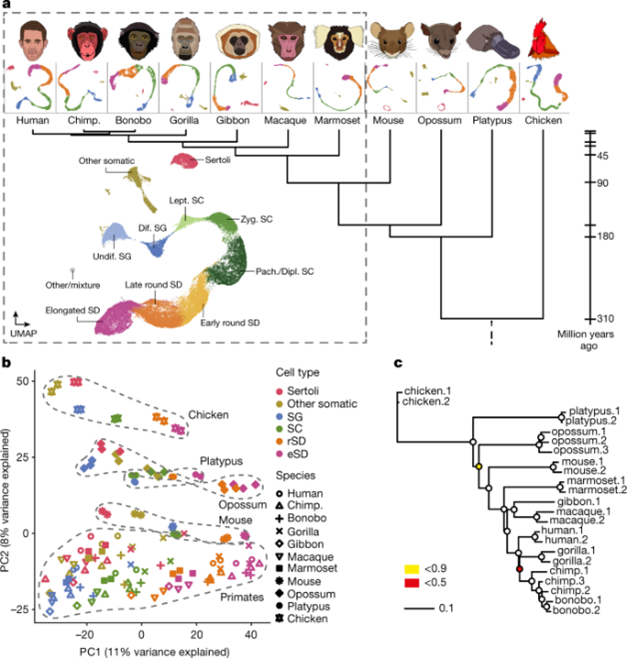Human semen quality is remarkably poor, with a reduced efficiency of spermatogenesis. Studies revealed that latter complex process has undergone rapid evolutionary changes. Male infertility is increasing which leads to a concomitant higher demand of assisted reproductive technologies. As other primates have not experienced the same decreasing fertility, a multicenter study sought to uncover the molecular spermatogenic evolution across various mammals with an aim to reveal essential genes involved in the mammalian sperm production and clarify the decreasing human male fertility. In the study published in Nature1, the molecular evolution of spermatogenesis is reported in ten mammalian species, including humans, primates, marsupials, and egg-laying monotremes and one bird as an outgroup. By using single-nucleus RNA sequencing on testis specimens from these species, the authors were able to dissect the transcriptomic changes that occur in each cell type throughout the process of spermatogenesis, and thereby investigate the evolutionary changes that have occurred during the last 310 million years.

This multi-center study discovered that the previously reported rapid evolution of the testis is driven by the late spermatogenic stages, probably as a consequence of evolutionary factors like haploid selection, expression pleiotropy, and transcriptionally permissive chromatin. Thus, the late spermatogenic stages have been more susceptible to transcriptional changes compared to the early stages. Also, the researchers were able to distinguish X- and Y-bearing spermatids allowing investigations of transcriptional differences between these and uncovered that meiotic sex-chromosome inactivation also occurs in monotremes making it an ancestral mammalian mechanism. The results also show that genes on the X-chromosome are enriched, so-called conserved, in the spermatogonia and Sertoli cells (supportive cells) probably due to male-beneficial selection during evolution. Finally, the team generated an open source platform to facilitate further research across the field. Overall, the data generated as part of this study provides a valuable resource for further research into the molecular evolution of spermatogenesis, and genes with changed transcriptional trajectory may play a role in the declining efficiency of human spermatogenesis. In a clinical aspect, these evolutionary findings create a resource to investigate causes of male fertility disorders and uncover the function of genes crucial for the sperm production and testis biology.
1. Murat, F. et al. The molecular evolution of spermatogenesis across mammals. Nature 613, 308–316 (2023).
https://www.nature.com/articles/s41586-022-05547-7
